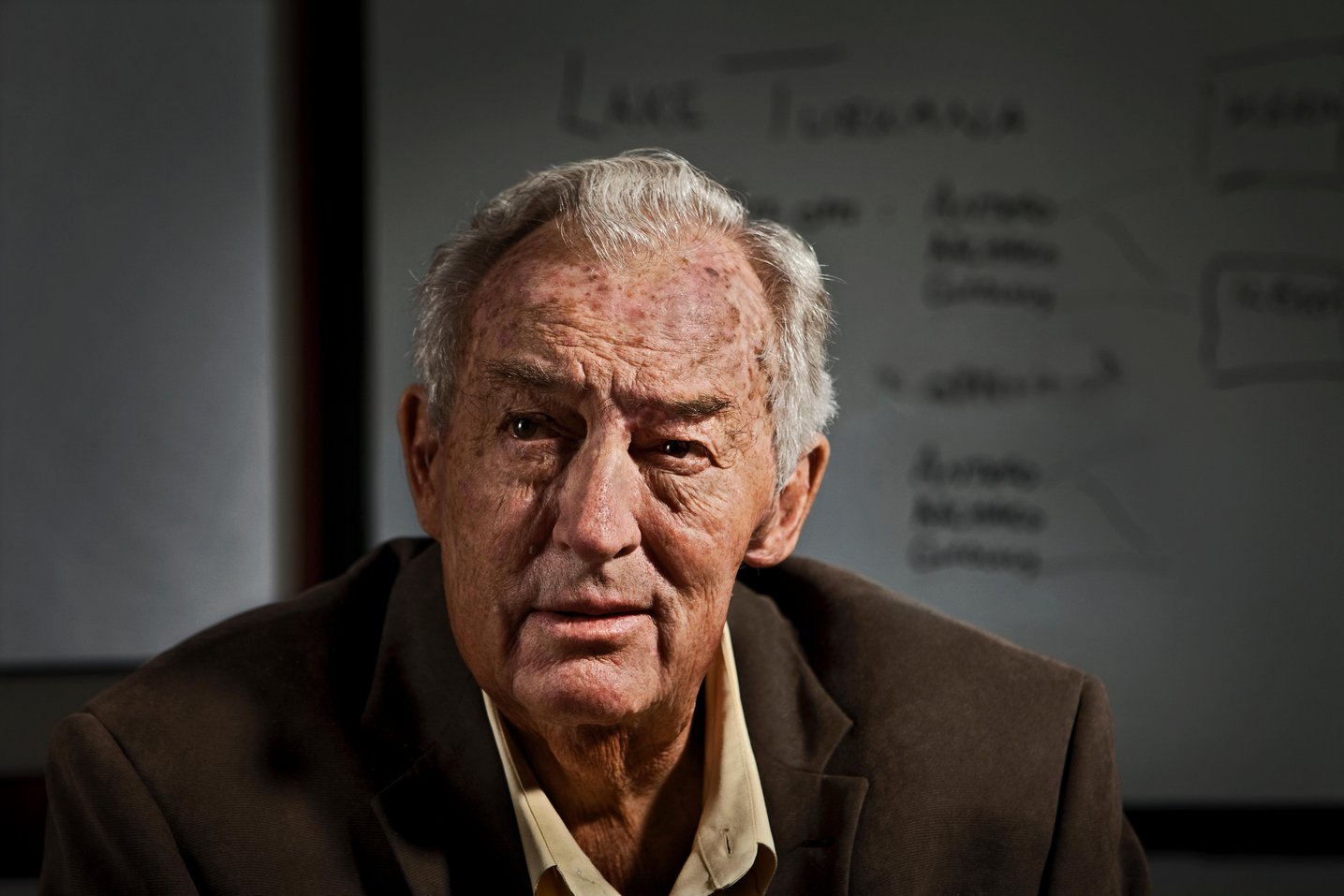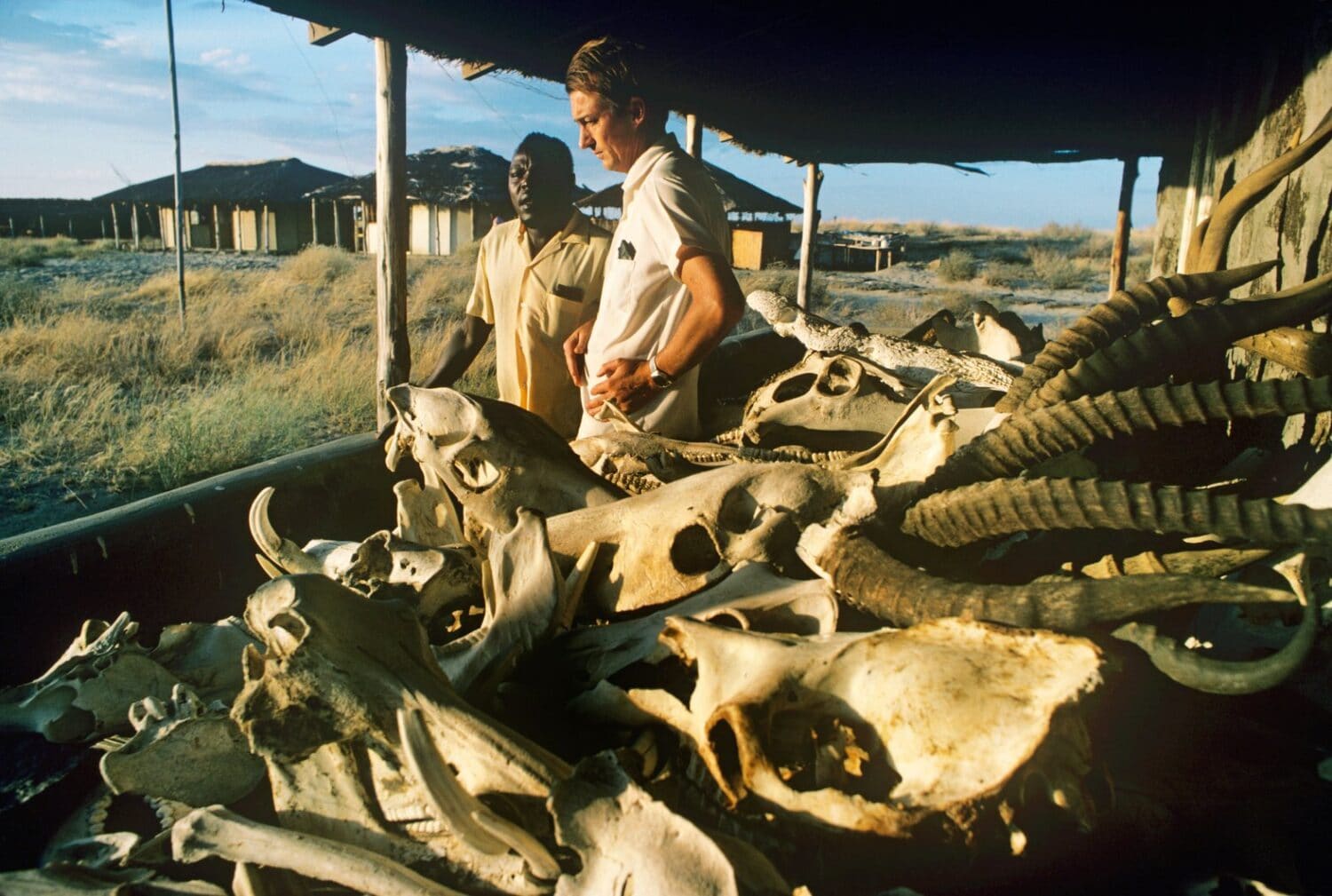
Paleoanthropologist and conservationist Richard Erskine Frere Leakey, whose discoveries helped show that humankind evolved in Africa, died on January 2, 2022, at age 77.
Leakey was a professor of anthropology at Stony Brook University and the founder and director of the Turkana Basin Institute, a nonprofit organization that provides multidisciplinary research facilities to support scientific work in Kenya’s remote Turkana Basin. He served his home country of Kenya in several official capacities, including as director of the National Museums of Kenya and director of the Kenyan National Wildlife Service. He started Wildlife Direct, a wildlife conservation organization. He was also a Life Trustee of The Leakey Foundation.
Speaker of the United States House of Representatives, Nancy Pelosi, said on Sunday, “Today, the world lost a pillar of the paleoanthropological community in Dr. Richard Leakey, who for decades blessed us with groundbreaking discoveries. Together with his father, Dr. Louis S.B. Leakey, and his mother, Dr. Mary Leakey, the family pushed the boundaries of human knowledge and forever altered our understanding of human evolution. He was also a legendary conservationist who led the charge to save the African elephant from extinction and helped preserve Kenya’s natural environment. And, as Head of Public Service, he helped combat corruption and strengthen government institutions.
“Officially, it was my great privilege to serve on the Board of The Leakey Foundation, which for more than five decades has advanced the bold vision of scientific leadership that Richard shared with his pioneering parents and his accomplished wife, Meave. Personally, Richard was a dear friend, and my family had the thrill of seeing this work firsthand when we accompanied Meave and him on a dig in the Lake Turkana area of Kenya.
“May it be a comfort to Richard’s wife and partner in science Meave, his three dear daughters, Anna, Louise and Samira, and all of his loved ones that so many in America and around the world mourn with them during this sad time.”

Image by Marion Kaplan/ Alamy
For most of Richard Leakey’s life, science was a family endeavor. Leakey was involved in his parents’ human origins research from an early age, and he found his first fossil when he was only six years old. As a young man, he wanted to do something different than paleoanthropology, but he eventually found his way back to the field.
During the 1960s and 70s, Leakey made discoveries that shed new light on human origins and made him a household name. At 23, he led the Kenyan contingent of an international expedition to Ethiopia’s Omo Valley, where his team found two early Homo sapiens fossil skulls that they named Omo I and Omo II. In 1968, Richard Leakey became director of the National Museums of Kenya. In 1972, he found a 1.9 million-year-old Homo skull that came to be known as “1470.” This skull showed that early members of the genus Homo had developed large brains much earlier than previously known.
In 1984, Leakey and his team, nicknamed “the Hominid Gang,” made their most monumental discovery–the nearly complete skeleton of a Homo erectus youth. The 1.6 million-year-old fossil was nicknamed “Turkana Boy” or “Nariokotome Boy.” It is one of the most significant paleoanthropological discoveries of all time.

Throughout his career, Leakey was a skilled and inspirational communicator. He gave lectures, wrote bestselling books, and hosted television shows that opened the world of human evolution research.
Leakey believed that it was vital for African scientists to be leaders in human origins research. He mentored and supported many Kenyan students and helped them pursue careers in science. He was an advocate of The Leakey Foundation’s Baldwin Fellowship program, and he helped dozens of Baldwin Fellows launch their careers.
“Richard Leakey was a pioneering scientist, a champion of wildlife conservation, and a great humanist,” Leakey Foundation president Jeanne Newman said. “We at The Leakey Foundation, originally begun by his father, Louis Leakey, have always admired Richard Leakey for his important contributions to human origins research and his lifelong dedication to conservation and education. On behalf of The Leakey Foundation, I send heartfelt condolences to Richard’s family, colleagues, and friends.”
“We are saddened to hear of the passing of Dr. Richard Leakey, one of the great scientists of his time,” wrote Leakey Foundation trustees Erica Brown Gaddis and Elise Brown Ersoy. “Our father, Dr. Francis Harold Brown, began collaborating with Richard and the Leakey family in the late 1960s and considered him a dear friend at the time of his passing in 2017. Dr. Brown especially enjoyed his time in the field with Dr. Leakey, both for the tremendous scientific discoveries they shared and the many adventures of field life in Northern Kenya. Dr. Leakey’s legacy in human origins and wildlife conservation remains an inspiration, and we are pleased that The Leakey Foundation can support advancing Dr. Leakey’s life work. Our hearts go out to his family.”
The Leakey family, through Richard Leakey’s daughter, Samira, released a statement on his passing:
“On Sunday 2 January, we lost a true warrior, an individual so large in presence that he left a void that can never be filled. He has been described as iconic, and a force of nature, but to us he was Richard, Dad, and Babu. As a family, we are enormously grateful for the outpouring of warmth and support that we have received from so many friends here in Kenya and across the world. It brings us great comfort to know how much his life meant to so many.”
The family noted that in keeping with his wishes, Leakey’s body was interred on his favorite ridge, “overlooking the majestic Rift Valley that he so loved.”
Tributes to Richard Leakey may be left online at the ForeverMissed memorial site.
Comments 2
FARE THEE WELL, DR. RICHARD LEAKEY.
I met this collosal man decades ago while he was the Director at the National Museums of Kenya. I was a university student at The University of Nairobi. We had one of those long vacations between semesters and I needed something to do. I left my room in Hall 12 and I took a brisk walk , aimlessly walking and thinking. I walked past Hotel Boulevard and across the bridge and found myself at the Museums of Kenya.
I saw a man sweeping jacaranda leaves and flowers off the gravel car park. I then saw a wooden sign with an arrow pointing southwards saying DIRECTOR’S OFFICE. I asked the groundsman who the director was. He pointed to a tall white man. He was younger and good looking then. The groundsman advised me not to interrupt Dr Leakey while he is taking to his guest outside. I should wait till he gets back to the office then follow proper protocol with his secretary. Sage advise from a man most people ignore..I never take anyone for granted.
So I waited and gave him time to get back inside. I went to the secretary Ms Teresa, and told her a long tale about how Dr Leakey had come and lectured us on campus. ( Now this was true. My college mates had him as a guest lecturer in the Archeology class ) .
I told the secretary that I had some follow up discussion questions for him.
She is the best secretary of a big boss I have ever seen. She is so professional unlike those arrogant bosses and their secretaries who behave like small gods and goddesses. . She ushered me into Dr Leakey’s s office without further ado.
I found Dr Leakey seated back in his chair in his office. This is a world famous man who is a personal friend of Kings and Queens but he was so down to earth and treated everyone the same. This is a man who had a reserved seat at British , Dutch and God knows who else royal functions.
I changed my tale and confessed that I had told Teresa a fib to let me in. I told him my real mission was we had a super long vacation so I needed a job during the long break. He told me he had no more temp jobs because the department of Culture had no budget for temps anymore. I persisted . We argued back and forth. It turns out that he liked persistent people. He had a hearty laugh. He finally agreed to give me work in his labs. He agreed to pay me from his own pocket.
I started working that Monday. It was the best experience of my life to date. I started with working on his archive. I had to arrange all the newspaper and magazine cuttings from all over the world that had chronicled his visits all over the World.
I have never worked so hard for anyone in my life. After finishing his personal papers , I was given assignments in different departments at the Museum. The Paleontology Department was headed by his wife ,Dr Meave Leakey. I worked with him in his area of specialty which is Paleo Anthropology.
Ir was such a pleasure to work at the Museum. Dr Leakey had an open door policy. Anyone could pop into his office for a chat so long as he was not busy. Teresa always let anyone in. I took full advantage of those visits. I would go and chat and laugh and learn from this great man. I world introduce him to my friends and relatives as if he was a friend. A man who sits with royalty would make time for me.
…
I came to the US but kept in touch. Everytime I landed in Kenya I would go to see his wife ,Dr Meave at the Museum and she would tell me where to find him because after retiring from Kenya Wildlife Service, he wanted privacy. I was lucky to get his audience. He had this cheerful face and a booming radio voice.
Dr Richard Leakey had an elephant’s memory. He never forgot me. For a person who meets thousands of people I was always amazed that he always remembered me.
He used to come to a university where I taught in North Carolina for a lecture series. It’s called Guilford College.
This university has a huge auditorium for such events. I always attended all his lectures and trust me he would see me and mention my name as a fellow Kenyan.
Richard Leakey was proud to be a Third Generation Kenyan. Since he is so famous , the British claimed him but he insisted he was Kenyan.
The last time I went to Kenya 2020 I never paid him homage because of Covid ; No contact rules.
I considered him a friend. He was an inspiration and someone I admired because of his resilience. After all his accidents, loss of his foot and leg plus kidney , he never stopped. He expanded The Museums and , KWS to world status.
Dr Richard Leakey wrote me a recommendation/ reference letter which I have to date. When I went to South Africa , everyone at the University of Natal thought I was a very important person because I knew Dr Leakey personally. I was treated so well and given a seat at the high table whenever there was a college function. I remember sitting on the dias with Thabo Mbeki and Mongesuthu Buthelezi in Durban just because I was associated with Dr Leakey. South Africans Revere him , just like the Dutch. He was a personal friend of the Prince of Netherlands and the former Queen Beatrix. The Dutch also thought I was all that because of my affiliation with Dr Leakey.
Sasa nitaambia Watu nini ,?
May his soul rest in eternal peace. 😭
Esther, thank you for sharing this wonderful story and your memories of Richard Leakey.